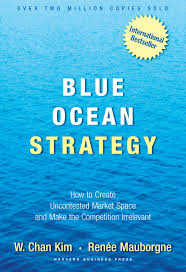 The Blue Ocean Strategy leadership strategy has been around for a number of years, ( W Chan Kim and Renee Mauborgne pub, 2005). Considered an all-time classic management book it encourages today’s leaders to stop competing, get ‘innovating’ and yes, start swimming in your big blue ocean!
The Blue Ocean Strategy leadership strategy has been around for a number of years, ( W Chan Kim and Renee Mauborgne pub, 2005). Considered an all-time classic management book it encourages today’s leaders to stop competing, get ‘innovating’ and yes, start swimming in your big blue ocean!
But how exactly do we define then refine the innovation message? One of the things we know for sure about innovation is that it is ‘thinking outside the box’ i.e. changing the way we think about doing things and we all know that is not the easiest things to do! Even though we live in a world now where things change in front of us daily: new and improved technology gadgets …digitized and robotic processes.
Chan Kim and Mauborgne say that there are 3 propositions for success when we consider the highest level of strategic leadership:
- VALUE proposition (an offering that attracts buyers)
- PROFIT proposition (creating a business model that enables the company to make money
- PEOPLE proposition (motivating the people who execute the strategy)
They further suggest that most organizations stay safely within the RED Ocean strategy when they fail to incorporate all 3 propositions
But there are those who adopt the Blue Ocean strategy and step out on their own ledge. Let’s take some success stories like Facebook founder Zuckerman whose venture captured millions who simply want to ‘chat and share’. This venture has turned it into a billion-dollar industry called ‘social media’ which most business leaders rely on as part of their marketing campaigns to get ‘the word out’
Another great example is Google, where you can find just about anything on the internet using SEO (Search Engine Optimization) and Google Analytics to track online marketing success
… And now Blue Ocean ‘brings it home’! Here in Trinidad and Tobago, a group of shrewd business innovators called ISLAND PEOPLE have mastered the Blue Ocean strategy in the art of mas making (costumes) during the local Carnival celebrations. Using the internet and a shoebox delivery service they’ve brought convenience, comfort and a new value proposition to those willing to pay for it. With a few collaborations they’re also able to use Apps and a few ‘taps’ so masqueraders world over can order costumes, secure airline tickets, book accommodations, and pay for non-stop partying, music and drinks way ahead of the much touted “world’s greatest festival”.
The whole idea of Blue Ocean Strategy is to move away from slugging it out with your competitors and finding ‘blue oceans’ i.e. new market spaces to grow your business
In the world of technology today just think of the possibilities for e-commerce, bio and nano technologies and more. Then push the clock forward and ask how many now unknown industries are likely to exist as a result of these technological developments that emerge almost everyday. It’s time to swim in our own blue ocean!


 Just recently I had an encounter with a 14 year old special needs student who opted to spend the first 15 minutes of classroom time sulking through a project which he seemed to have no interest in. After several attempts to get him on board with what the class was doing (stencil design to create their own paper montage) I found it better for him to be the ‘color custodian’ for the evening: that meant he got to select colors for each table in keeping with the designs they chose. A task which required some color coordination skill (which he had!) and which would’ve taken extra time for me to complete. Needless to say, we were all happy in the end. (We’ll discuss ‘rules are meant for everyone’ at another time.)
Just recently I had an encounter with a 14 year old special needs student who opted to spend the first 15 minutes of classroom time sulking through a project which he seemed to have no interest in. After several attempts to get him on board with what the class was doing (stencil design to create their own paper montage) I found it better for him to be the ‘color custodian’ for the evening: that meant he got to select colors for each table in keeping with the designs they chose. A task which required some color coordination skill (which he had!) and which would’ve taken extra time for me to complete. Needless to say, we were all happy in the end. (We’ll discuss ‘rules are meant for everyone’ at another time.)




